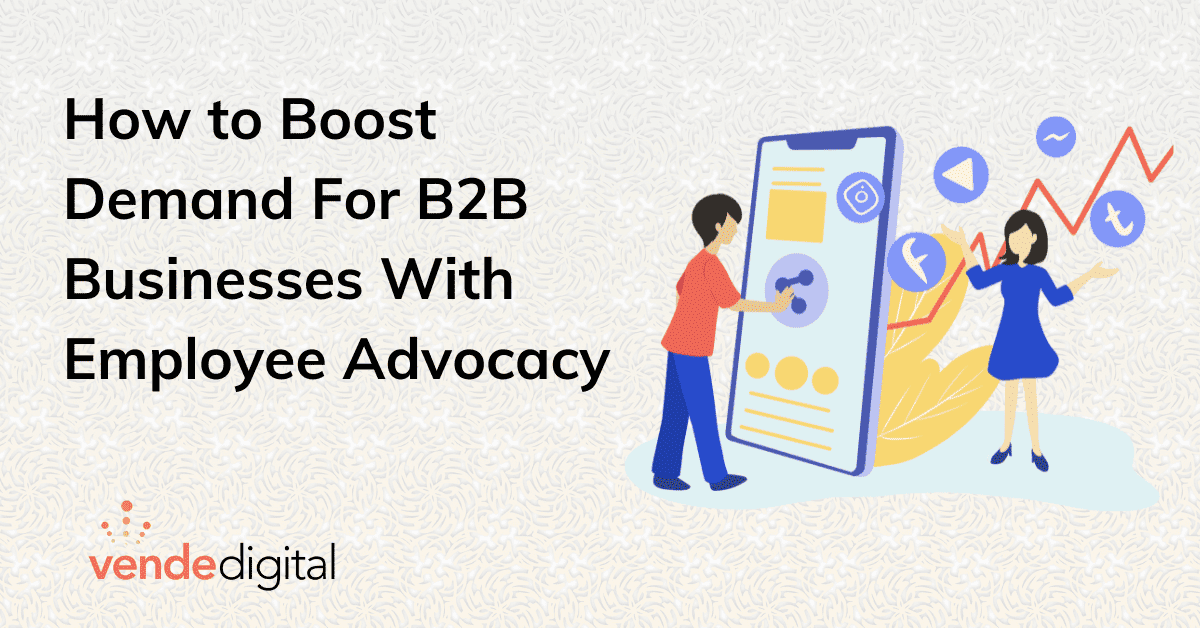
How Can Employee Advocacy Boost Demand for B2B Businesses?
Social media has revolutionized the way B2B businesses connect with their buyers. But with everyone on social media these days, it has become harder to attract attention using your company's social media accounts alone. This is where employee advocacy can be an effective strategy to amplify your brand and attract opportunities to grow your business.
Nearly 64% of employees say employee advocacy helped them attract new business, and almost 45% say it helped generate new revenue streams, according to a study by Hinge Research Institute.
In this article, we'll delve deeper into the concept of employee advocacy on social media, exploring the benefits, risks, and how to implement an effective program.
How can Employee Advocacy Benefit your B2B Business?
Many hands make light work, and social media advocacy is a way to use the many voices of your employees to elevate your brand on social media. This can increase your visibility and build a more personal connection with your audience.
Benefits of social media advocacy:
- Increased brand awareness and visibility.
- Enhanced trust and credibility of your brand.
- Assists in social selling and attracts inbound business.
In 2023 there is no excuse not to have a social media presence beyond your company page. Help your team find their voice and multiply your social reach exponentially.
What is Employee Advocacy for Social Media?
Employee advocacy involves actively encouraging your employees to create visibility for your business using their own personal social media profiles. The goal is to increase your social media reach and stimulate opportunities by getting your employees involved. And they can do this by actively promoting your company's content while building their own personal brand.
The key is to allow employees to share their points of view and discuss them in a natural way that encourages buyer engagement and discussion. But they can also share things like, what is happening in your company, events, and new product launches, or showcase what it's like working at your company.
And this should be something that is encouraged from the C-suite to the juniors working in your organization. The more employees jump in and get involved to support each other, the greater your visibility and reach can be.
A well-executed employee advocacy program has the potential to extend your organic reach by up to 200% and increase your profitability by 23%, according to Hootsuite.
When employees become advocates for your company, they can help to build trust and credibility with potential buyers. Their personal networks will extend the reach of your business far beyond what your company's social page can do.
But to do this requires a supportive culture, resources, and training. And if done right, it can be a highly effective way to drive brand awareness, improve customer engagement, and ultimately grow your business.
Employee Advocacy: Risks and Challenges
Anytime your employees are engaged in a public discussion, they need to be aware of the risks associated with it. What they say can impact your company’s public image. And it is crucial that your company creates clear guidelines for employees to follow.
And if anything does happen that causes negative attention, employees need to know what to do and who they need to speak to if they face any public relations issue.
Mixed Signals from Employees
When employees are given the freedom to share content on behalf of your company, there is a risk that the way they communicate may not align with the company's brand or values. This could potentially lead to confusion amongst the public about what your company does and what its values are.
Be sure to create guidelines that employees can follow to help them understand how best to talk about your business while maintaining a consistent brand image.
Sharing Confidential Information
If an employee accidentally discloses confidential or sensitive information about your company or its clients, this could lead to legal and reputational risks. Be sure to set clear boundaries of what can and cannot be shared to avoid any unintentional disclosures.
As long as your employees are clear about what they can say and respect the confidentiality of your company and customers, there should never be an issue.
Lack of Employee Involvement
Some employees will be more socially adept than others, which means the introverts in your company may need additional encouragement and support. If they are not supported, it may lead to fewer employees getting involved and reduce the effectiveness of your employee advocacy program.
Create opportunities for employees to get together to discuss challenges and support each other to help those struggling to get started or to maintain their presence.
How to get started with Employee Advocacy?
You may be hesitating to take the first step to start your own employee advocacy program. It may feel like a daunting task, especially if you are a larger B2B firm.
Here are a few things you can do to make it easier to begin.
Start with the C-Suite and CEO
A Gartner survey found 40% of B2B buyers use social media to help them gather information to make better purchasing decisions.
This is an opportunity for CEOs and leadership to take a role in sharing and engaging with buyers. We see this with successful brands whose CEOs are visible and vocal in sharing their thoughts, vision, and products.
Leaders like Elon Musk, Richard Branson, and Gary Vaynerchuk are just a few who lead their companies on social media.
And it’s a powerful way to leverage the authority of your CEO while it sets an example for your employees to follow.
Meet with your CEO
You can begin by meeting with your CEO to discuss the advantages of being visible on social media. Explain how building their personal brand can have an effect on the image of the company, and can be a channel for creating demand for your products and services.
Set a time to discuss and capture their thoughts to use as content. Then get them to share it on their social profiles.
Once they share content, encourage them to engage with their connections and showcase their personality in the comments.
Get the C-Suite together
Once your CEO is onboard and you have the green light, you need to speak to the rest of the leadership team. Present how a coordinated social media initiative can have a powerful effect on public perceptions.
You can share the statistics and examples of how companies use employee advocacy to generate demand for their business and create opportunities to connect with your ideal buyers.
Encourage Employees to Engage on Social Media
While only 3% of employees share content about their company, those employees who actively share are responsible for driving a 30% increase in the total engagement a company sees, according to LinkedIn.
The fact is that employees are your biggest spokesmen. They each have their own networks of people, which, pooled together, can be significant.
Help them understand the value of being visible on social media and what it can do for their reputation and your company's brand.
Encourage them to create content that feels natural to them and is not simply “cut and paste” company content recycled into a LinkedIn post. Allow them to share their own thoughts, opinions, and experiences within your company.
Sharing this kind of content can help boost your brand reputation with both customers and potential new recruits, which will build momentum over time.
Motivate Employees to build their Personal Brand
Many B2B companies are afraid of encouraging employees to build their own personal brands on social media. And they may place red tape at every corner until employees feel discouraged and finally give up.
Although your employees work for you, you don't own their social footprint; they do. A better strategy is encouraging them to grow their personal brand while creating visibility for your business.
And encourage them to share their unique point of view. This will help them establish themselves as thought leaders and influencers in their domain of expertise. As they grow their influence, this will naturally filter down to your own business.
By motivating your employees to build their own personal brands, you will only amplify the number of voices speaking about your business, and this will increase your visibility and reach.
Share Social Media Resources for Your Employees
Creating content can be a challenge for even your most enthusiastic employees. But you can make it easier for them by providing the appropriate resources.
One way to support them is by creating a centralized library of content they can access and use as required. This can reduce the friction for employees starting out, and help keep content assets that can be repurposed available to all your employees.
You can also create a shared swipe file that can be used to collect interesting ideas, content, links, articles, or other related material.
These resources can include:
- Library of ready-to-go social posts.
- Writing prompts and frameworks.
- Headline ideas.
- Images, memes, etc.
While not every employee will want to do this, it will be a great resource for those interested in producing content on a consistent basis.
Encourage Employees to Support Each Other
Employee advocacy isn’t a single-player game. It's best done with as many of your team as possible. Even if not everyone creates content, those that don’t can support other team members by liking, commenting, and sharing their posts.
Encourage your team to get involved in social discussions, both on each other's posts and on posts that offer an opportunity to showcase their expertise. This can be a great way to get attention from potential buyers looking for people of value to follow.
You could consider creating a Slack channel where team members can share links to their posts, share wins, and encourage each other to maintain consistency.
Host a Regular Social Media Discussion
A great way to stimulate interest among employees is to host a regular discussion where employees can share their ideas, thoughts, and experiences together, face to face.
This can be an opportunity to acknowledge employees that have made significant contributions and have experienced good results from their efforts. But also encourage employees that are struggling to get started.
Share your best practices, insights, and learnings to help your team improve their content and even better content for your buyers.
Publish guidelines for Employees to Follow
Every company is different, and there may be companies that have legal restraints as to what they can and cannot share. You don’t want to take the wind out of their sails before they set out, but just be sure to set guidelines to avoid any trouble.
These guidelines can include what information they can disclose about your company or customers and when they need to seek advice.
But it can also include guidelines for what language, topics, or content that could be deemed inappropriate and damaging to both their reputation and your company’s public image.
Key Takeaways for Employee Advocacy: How to Boost Your Company's Social Media Presence
Employee advocacy can have a compounded effect on the visibility of your B2B business. And getting your team involved can have major benefits.
Here are key points to remember:
- 64% of employees say employee advocacy helps them attract new business
- Employee advocacy should be led from the top down, starting with the CEO.
- 40% of B2B buyers use social media to help them make purchasing decisions
- Encourage employees to build their personal brand and share their perspectives.
- Provide resources to support your employees to ease content creation blues.
- Get together as a team to brainstorm, discuss and support each other’s wins.
- Set out guidelines to help employees avoid sharing sensitive material.
- Employee advocacy can extend organic reach by up to 200%.
How Can We Help?
Finding the time to build and execute a paid B2B social media strategy can be daunting. At Vende Digital, we help B2B organizations like you to develop sound strategies to grow on social media.
Tired of struggling on your own?
Schedule a complimentary discovery call with our team, to see how we can amplify your social media advertising campaigns to win more customers.







